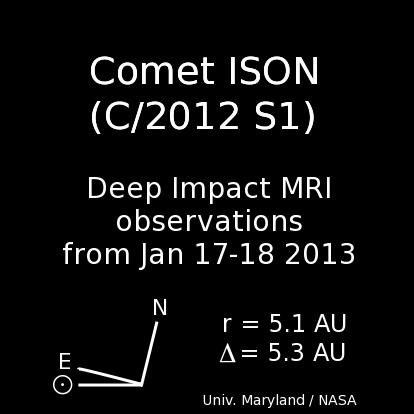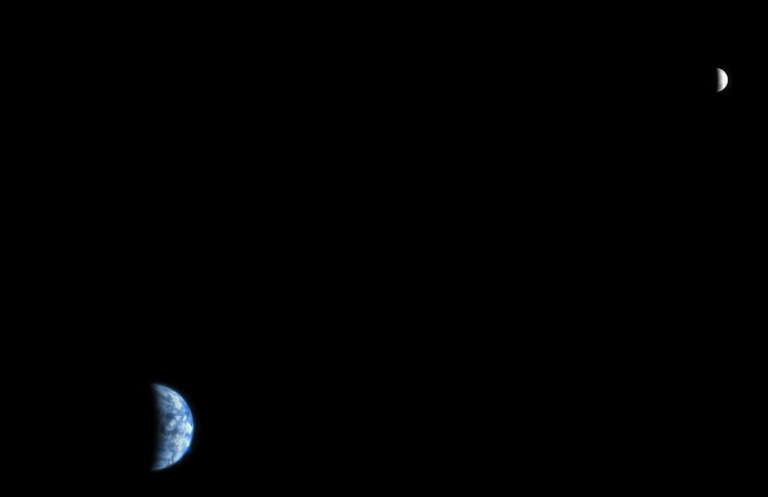Daniel Fischer • Aug 09, 2013
Interplanetary eyes on the lookout for comet ISON
The much-awaited comet C/2012 S1 (ISON), has been prematurely called "comet of the century" but is, at least, a highly unusual visitor from the edge of the solar system. It has been teasing professional and amateur astronomers alike in the past two months, when it has been invisible in the glare of the Sun. This is a purely geometrical effect: ISON is still 2.5 times farther from the Sun than the Earth, but is on the other side of the Sun.
Some time in August, eager amateur observers should be able to pick the comet out of bright dawn skies, as its angular distance from the Sun grows throughout this month from 12 to 30 degrees. At perhaps 13th magnitude, ISON will still be an exceedingly faint object, in reach of only die-hard astrophotographers. But there are more eyes in the solar system than those on or near Earth, and at an international workshop to coordinate observations on August 1 and 2 at the Johns Hopkins University Applied Physics Laboratory in Maryland, team members from several interplanetary missions joined colleagues from ground-, balloon-, plane-, rocket- and orbit-based telescopes to share their plans.

One spacecraft that will be called into action later is NASA's MESSENGER in orbit around Mercury: it will have an interesting vantage point when ISON approaches the Sun in November. But the first deep space mission to recover ISON - right now, actually - is Deep Impact's old fly-by spacecraft which, after visiting two comet nuclei and doing some exoplanet astronomy with its camera, had already observed ISON in January. Now the "DIF" is in a much better position than the Earth and is supposed to observe ISON, mainly for infrared spectroscopy, on August 8 and 9. The data downlink is slow, as Deep Impact is now more than twice as far from Earth as the Sun, and will follow on August 10. More observations are possible until August 16 in the infrared and September 12 in visible light. Then the comet is too close to the Sun from Deep Impact's unique vantage point and can only be observed again way into 2014 -- assuming that the comet even survives its close brush with the Sun, of course, something no one at the meeting was willing to bet on.

Next in line is the Mars Reconnaissance Orbiter (MRO), which will be in a perfect spot in late September when comet ISON approaches Mars to within 11 million kilometers -- six times closer than it will ever come to Earth (64 million km on December 26). While MRO's HiRISE camera in particular has occasionally been used as a telescope to look for example at the Earth - Moon system, it is optimized in every respect for scanning the Martian surface. So while both HiRISE and the infrared instrument CRISM will be used during the comet's approach, a lot of guessing is involved in planning the exposures. Therefore the MRO team is happy to join Deep Impact on August 20 for some early remote observations of ISON: the viewing angle is unproblematic as Mars is still on the far side of the Sun and thus closer to ISON than the Earth, but the distance will still be 151 million kilometers. This translates into a poor resolution of HiRISE on the comet of 150 km per pixel, the signal-to-noise ratio won't be great, and CRISM might not see anything at all - still both instrument teams are happy for this opportunity of a little trial run.

In the -- still growing -- consolidated timeline of planned observations, DIF and MRO are the only contributors from the professional side in August. But, come September, the ISON campaign will take off -- literally! -- as even a balloon and a rocket launches are in preparation and numerous astronomical satellites will be called to duty in addition to ground-based telescopes (of the nightly, radio and even of the solar kind) and amateur astronomers invited to contribute to specific projects. It is a matter of debate if this is the greatest astronomical campaign devoted to a single object of all time: the spread of observing eyes from Mercury to Mars certainly is. But what's missing is the fleet of spacecraft actually going to visit the comet itself that defined the also very huge campaign awaiting Halley's comet in 1986. The return of Halley's comet had been predicted for centuries, though, while ISON was only discovered in September 2012.
This comet has moved into the crosshairs of science not so much because of its potential -- but not in any way guaranteed -- coming great brightness and impressive tail that may be visible for a few days in December. It is the never-before-observed combination of a fresh comet from the Oort cloud -- way beyond even the planets and the Kuiper belt -- that will come to within 1.2 million kilometers of the solar surface! And was discovered 14 months before that encounter with destiny, also unheard of for such a "sun-skirter". ISON's behavior in the past year has been puzzling, with a stupendously flat lightcurve in the first half of 2013; interpretations at the workshop varied widely and ranged from a mostly dry dustball, soon to crumble, to an ice-rich body that already underwent a prolonged outburst just fading back to normal. Survival of the tiny nucleus -- less than 4 kilometers in diameter, according to the best Hubble images -- closest to the Sun is not guaranteed either. Not only the solar heat but even tidal forces will be uneasily close to destructive. For that reason, plans for another emergency workshop or video conference in December were already mulled at the August meeting so that the ISON campaign could react promptly to the comet's fate.

Let’s Go Beyond The Horizon
Every success in space exploration is the result of the community of space enthusiasts, like you, who believe it is important. You can help usher in the next great era of space exploration with your gift today.
Donate Today

 Explore Worlds
Explore Worlds Find Life
Find Life Defend Earth
Defend Earth

